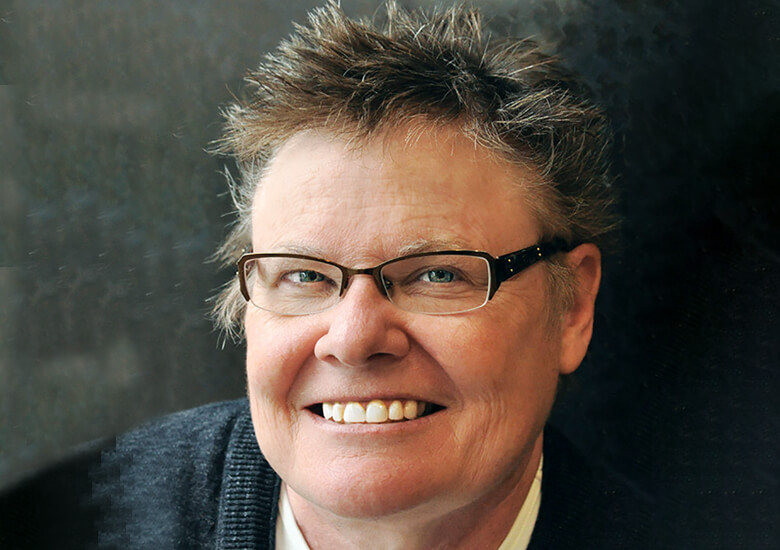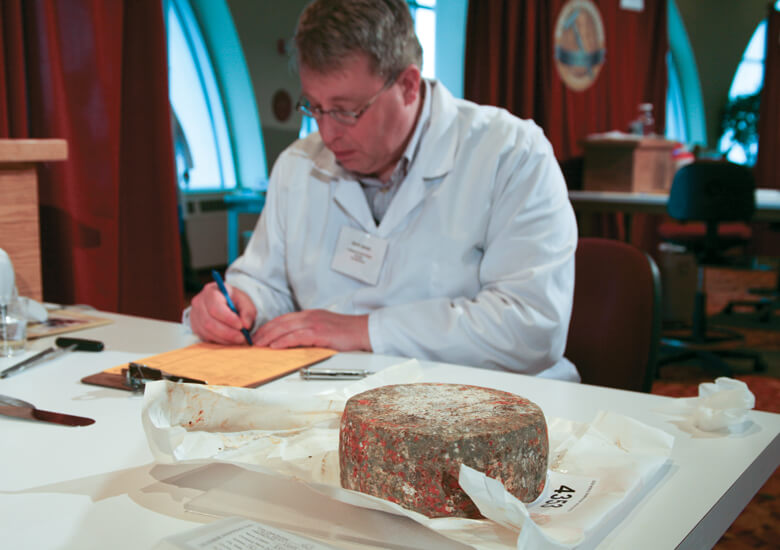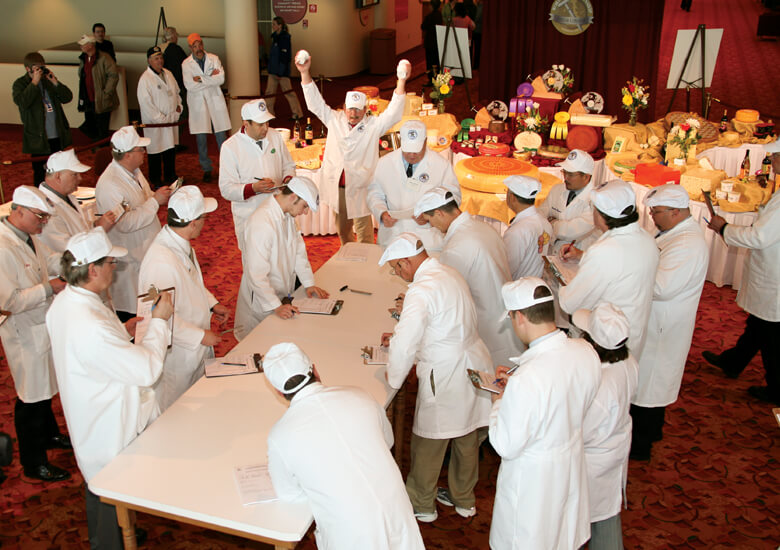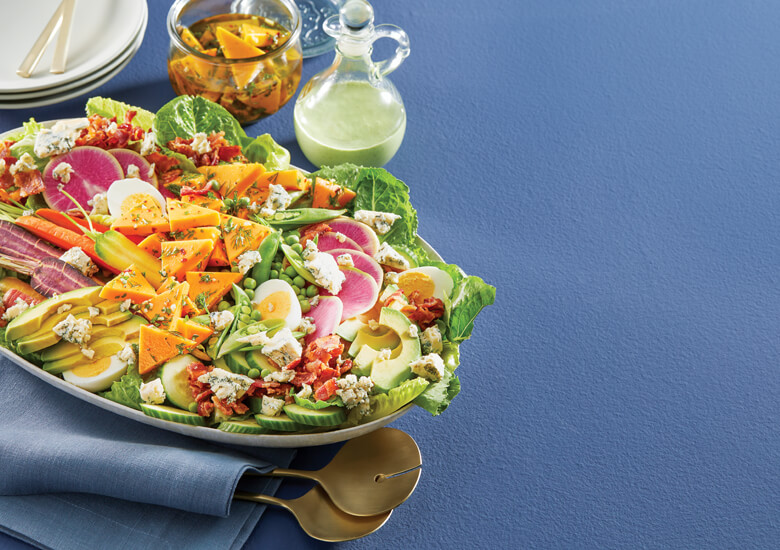Competitions. They bring out our finest, test our boundaries and push us toward perfection. It’s no different for
cheesemakers. Prestigious cheese competitions like the World Championship Cheese Contest, United States Championship Cheese Contest, and American Cheese Society Judging & Competition not only offer big-time bragging rights to
cheese artisans crafting at the top of their game but also advance Wisconsin’s cheese industry with feedback, turning great cheeses into the world’s best. Get an insider’s look into three renowned cheese competitions, learn about a day in the life of a cheese judge, and discover four championship cheeses that will win over any cheese lover.
A Winning Culture
Cheese competitions celebrate cheesemakers by showcasing their talents, excellence in cheesemaking and commitment to the craft. While only a few winners are awarded the coveted First, Second and Third Place spot in each category out of potentially thousands of cheese entries during these much-anticipated showdowns, everybody wins.
These contests support cheesemakers by providing feedback on how their entries stack up against similar cheeses from competitors. They’re welcome to review the results from expert judges, some of the most elite cheese professionals in the world. These evaluations include expert suggestions on what improvements cheesemakers might want to make to their cheese.
Our world-class cheesemakers lead the way and are innovators, so having a culture of open dialogue around quality is essential. Since they rank so well in these competitions, the events highlight the entire state’s cheesemaking community and the quality of the cheeses made in Wisconsin.
The Big Three
Here’s a look at three premier cheese competitions.
- The World Championship Cheese Contest has been hosted biennially by the Wisconsin Cheesemakers Association since 1957. This year’s competition runs March 5 to 7 in Madison, marking its 35th anniversary. Both the cheeses submitted and the team of technical judges evaluating the entries are from around the world.
- Hosted biennially by the Wisconsin Cheesemakers Association since 1981, the United States Championship Cheese Contest celebrates domestic cheesemakers. The last U.S. Championship Cheese Contest occurred in Green Bay in 2023, marking its 21st edition. A team of technical judges evaluates the entries.
- The annual American Cheese Society (ACS) Judging & Competition recognizes American-made cheeses for technical excellence and the highest aesthetic qualities. Teams of technical and aesthetic judges evaluate the cheeses. This format is crucial to cheeses that may not subscribe to traditional categories — cheddar blues, cheddar gruyere and more.
Meet These Esteemed Judges
Judging a cheese competition is an exceptional experience for even the most seasoned cheese professionals, and most will say it’s a high honor and privilege carrying tremendous responsibility. Cheesemakers enter their best cheeses, and the judges must be highly skilled; defects like aroma, flavor, body and texture, color, finish and other attributes are incredibly subtle. A great deal is at stake in their decisions, and a fraction of a point can make or break a cheesemaker’s day. We spoke with four industry professionals for an insider’s look at a day in the life of a cheese judge.

Marianne Smukowski
Outreach Program Manager (Retired), Center for Dairy Research (CDR) at the University of Wisconsin-Madison
- Marianne is an expert on food safety, quality and regulatory matters for the Wisconsin dairy industry.

Mark Johnson, PH.D.
Senior Management Team, Assistant Director, Center for Dairy Research (CDR) at the University of Wisconsin-Madison
- A National Cheese Institute Laureate Award winner, Mark's research interests include developing, manufacturing, and ripening protocols for unique cheeses and the study of cheese characteristics and cheese defects.
- Judge for nearly 25 years

Dean Sommer
Senior Management Team, Cheese & Food Technologist, Center for Dairy Research (CDR) at the University of Wisconsin-Madison
- Dean has been grading cheese for 38 years, and he’s a technical resource to the cheese industry, assisting manufacturers as a consultant and educator often involved with troubleshooting.

Molly Browne
Education Director, Dairy Farmers of Wisconsin
- An ACS CCP ® , CCSE® and vice chair of the ACS Certification Committee, Molly is the creator of Cheese State University, a resource for cheese professionals launched in 2023.

What is it like to judge a cheese competition?
Marianne: I feel so humbled to judge next to my fellow experts. To be chosen as a judge, they look at your background, knowledge and experience with the cheese varieties. It may also be based on your reputation in the cheese industry.
Mark: As a judge, I must know the cheese and how it’s made to give feedback. Fortunately, because of my experiences with European cheesemakers and technologists, I have a working knowledge of just about every type of cheese. I especially enjoy the World Championship Cheese Contest because I’m paired with a partner outside the U.S., and we can discuss what makes a good cheese. I get to learn.
Dean: There’s a ton of excitement, from seeing who wins the cheese categories or Best of Show to the crowd of folks observing us as we judge. My eyes are always drawn to the beautiful array of cheeses. The smells are also wonderful and, in some cases, almost overwhelming—smeared cheeses like limburger, peppery pepper jacks and the distinct aromas of blue-veined cheeses.
Molly: It’s a lot of responsibility and an endurance test, as it can be hard to keep your palate and brain in the game when judging the same style of cheese. Flavored and spicy cheeses are particularly hard (to judge) because you can get palate fatigue fast. Giving the same effort, attention and clarity to the cheeses you're judging towards the end of a category as the ones up front is really important.

How many cheeses do you judge in a day?
Marianne: I typically judge around 30 to 50 cheeses. You don’t want to judge too many due to sensory overload. For example, judging a pepper-flavored cheese, I may taste about 30 cheeses daily.
Mark: It’s usually between 45 and 55 cheeses daily for two days. On the final day, I will taste an additional 30 or more in the preliminary round and then 20 in the final round.
Dean: On average, I may judge 50 to 60 cheese samples distributed daily over 3 to 4 categories.
Molly: A lot. It’s possible to judge 50 to 70 on a typical day. It’s wild.

How do you train your palate to judge cheeses?
Mark: I taste and eat a lot of cheese. We evaluate hundreds of cheeses over the year at the Center for Dairy Research (CDR), many of which have faults. We also have courses on grading, judging and cheesemaking, and we make a variety of cheeses for clients, too.
Dean: The only way to educate my palate is by repetition and tasting more cheese. I taste many samples of cheese weekly, representing many varieties. I’m also constantly training my palate by tasting cheese with other experienced cheese graders and then sharing what we each taste in the sample.
Molly: I try to be thoughtful about everything I put in my mouth and focus on the abundance of flavors I interact with daily. It's one of the easiest ways to train because of the many opportunities to do it. Eating intentionally and paying attention to layers of flavor creates building blocks of flavor memory that help me judge cheese.

What defines ideal cheese, technically or aesthetically?
Marianne: When judging, I’m looking for the one cheese that defines the category. I want the flavor to stand out and the aroma pleasing with no texture or body defects and with a good appearance... it has to “knock my socks off” or have a wow factor to be the perfect cheese.
Mark: No off-flavors; we call it clean flavor. And the cheese has to taste like the variety it’s meant to be. Appearance is also important. For example, I want to see even veining throughout blue- veined cheeses, notably near the surface. A rind of more than ½ inch with no bluing is a fault to me. The flavor will be salty but not overwhelming, and the “blue notes” should be balanced. It’s a very complex cheese.
Dean: A technically perfect cheese has the correct appearance, color, texture and flavor for the variety. For example, I want to see a uniform color with cheddar, no seaminess or mottling. The pulled plug should be fused tightly, look like a candle with no holes or cracks, have a nice waxy feeling, and be smooth and firm. It will bend in the middle. The flavor should be pleasant, with cheddary notes and proper saltiness.
What are defects resulting in point deductions?
Marianne: In a cheese like cheddar or colby, I may taste acid, bitter, flat or lacking characteristic flavor defects. I may see a pasty and weak texture or body. Mottling or acid cuts would be faults in color.
Molly: Salt is a big one. All cheese has salt, but salt intensities are attributed to specific categories. Alpine- style cheeses are famously low in salt. If I taste a salty gruyère, it would be a defect. But feta is an intensely salty cheese, so too low salt would be a fault in its category.
Savor award winning cheeses
Wisconsin cheesemakers win more awards than any other state or country. Taste the quality and flavors of the award-winning cheeses in the following recipes.

Make it: Pineapple Foster Mini Dutch Babies

Make it: Marinated Colby Cobb Salad

Make it: Crispy Smashed Potatoes
